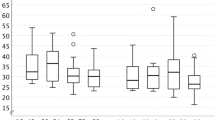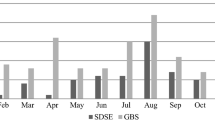Abstract
The importance of group C and G Streptococcus dysgalactiae subspecies equisimilis (S. dysgalactiae subsp. equisimilis) as a significant pathogen has recently been better recognized. S. dysgalactiae subsp. equisimilis disease can range in severity from milder skin and soft-tissue conditions such as wound infection, erysipelas, and cellulitis, to life-threatening necrotizing fasciitis and streptococcal toxic shock syndrome, thus sharing the clinical picture with S. pyogenes. The most common clinical manifestation of bacteremia is cellulitis. An increase in the incidence of S. dysgalactiae subsp. equisimilis bacteremia has been recognized. Invasive forms of this infection are most commonly found in elderly patients with underlying comorbidities and skin breakdown. The case fatality in bacteremia has been reported to be 15–18 %. In this review, the epidemiology, clinical characteristics, and emm types of S. dysgalactiae subsp. equisimilis bacteremia are summarized.
Similar content being viewed by others
References
Lancefield RC (1933) A serological differentiation of human and other groups of hemolytic streptococci. J Exp Med 57:571–595
Vandamme P, Pot B, Falsen E, Kersters K, Devriese LA (1996) Taxonomic study of lancefield streptococcal groups C, G, and L (Streptococcus dysgalactiae) and proposal of S. dysgalactiae subsp. equisimilis subsp. nov. Int J Syst Bacteriol 46:774–781
Vieira VV, Teixeira LM, Zahner V et al (1998) Genetic relationships among the different phenotypes of Streptococcus dysgalactiae strains. Int J Syst Bacteriol 48(Pt 4):1231–1243
Facklam R (2002) What happened to the streptococci: overview of taxonomic and nomenclature changes. Clin Microbiol Rev 15:613–630
Brandt CM, Spellerberg B (2009) Human infections due to Streptococcus dysgalactiae subspecies equisimilis. Clin Infect Dis 49:766–772
Broyles LN, Van Beneden C, Beall B et al (2009) Population-based study of invasive disease due to beta-hemolytic streptococci of groups other than A and B. Clin Infect Dis 48:706–712
Nei T, Akutsu K, Shima A et al (2012) A case of streptococcal toxic shock syndrome due to Group G streptococci identified as Streptococcus dysgalactiae subsp. equisimilis. J Infect Chemother 18:919–924
Haidan A, Talay SR, Rohde M, Sriprakash KS, Currie BJ, Chhatwal GS (2000) Pharyngeal carriage of group C and group G streptococci and acute rheumatic fever in an aboriginal population. Lancet 356:1167–1169
Reid HF, Bassett DC, Poon-King T, Zabriskie JB, Read SE (1985) Group G streptococci in healthy school-children and in patients with glomerulonephritis in Trinidad. J Hyg (Lond) 94:61–68
Ekelund K, Skinhøj P, Madsen J, Konradsen HB (2005) Invasive group A, B, C and G streptococcal infections in Denmark 1999–2002: epidemiological and clinical aspects. Clin Microbiol Infect 11:569–576
Rantala S, Vuopio-Varkila J, Vuento R, Huhtala H, Syrjänen J (2009) Clinical presentations and epidemiology of beta-haemolytic streptococcal bacteraemia: a population-based study. Clin Microbiol Infect 15:286–288
Auckenthaler R, Hermans PE, Washington JA 2nd (1983) Group G streptococcal bacteremia: clinical study and review of the literature. Rev Infect Dis 5:196–204
Cohen-Poradosu R, Jaffe J, Lavi D et al (2004) Group G streptococcal bacteremia in Jerusalem. Emerg Infect Dis 10:1455–1460
Sylvetsky N, Raveh D, Schlesinger Y, Rudensky B, Yinnon AM (2002) Bacteremia due to beta-hemolytic Streptococcus group G: increasing incidence and clinical characteristics of patients. Am J Med 112:622–626
Takahashi T, Sunaoshi K, Sunakawa K et al (2010) Clinical aspects of invasive infections with Streptococcus dysgalactiae ssp. equisimilis in Japan: differences with respect to Streptococcus pyogenes and Streptococcus agalactiae infections. Clin Microbiol Infect 16:1097–1103
Rantala S, Vuopio-Varkila J, Vuento R, Huhtala H, Syrjänen J (2009) Predictors of mortality in beta-hemolytic streptococcal bacteremia: a population-based study. J Infect 58:266–272
Kittang BR, Bruun T, Langeland N, Mylvaganam H, Glambek M, Skrede S (2011) Invasive group A, C and G streptococcal disease in western Norway: virulence gene profiles, clinical features and outcomes. Clin Microbiol Infect 17:358–364
Bruun T, Kittang BR, de Hoog BJ et al (2013) Necrotizing soft tissue infections caused by Streptococcus pyogenes and Streptococcus dysgalactiae subsp. equisimilis of groups C and G in western Norway. Clin Microbiol Infect 19:E545–E550
Loubinoux J, Plainvert C, Collobert G et al (2013) Adult invasive and noninvasive infections due to Streptococcus dysgalactiae subsp. equisimilis in France from 2006 to 2010. J Clin Microbiol 51:2724–2727
Liao CH, Liu LC, Huang YT, Teng LJ, Hsueh PR (2008) Bacteremia caused by group G streptococci, Taiwan. Emerg Infect Dis 14:837–840
Rantala S, Vahakuopus S, Vuopio-Varkila J, Vuento R, Syrjanen J (2010) Streptococcus dysgalactiae subsp. equisimilis bacteremia, Finland, 1995–2004. Emerg Infect Dis 16:843–846
Vartian C, Lerner PI, Shlaes DM, Gopalakrishna KV (1985) Infections due to Lancefield group G streptococci. Medicine (Baltimore) 64:75–88
Barnham MR, Weightman NC (2004) Changing incidence of detected streptococcal bacteraemia in North Yorkshire, England. Indian J Med Res 119(Suppl):160–163
Rantala S (2012) A population-based study of beta-hemolytic streptococcal bacteremia: Epidemiological, clinical and molecular characteristics. Doctoral thesis. Tampere University Press, Tampere
Davies MR, McMillan DJ, Beiko RG et al (2007) Virulence profiling of Streptococcus dysgalactiae subspecies equisimilis isolated from infected humans reveals 2 distinct genetic lineages that do not segregate with their phenotypes or propensity to cause diseases. Clin Infect Dis 44:1442–1454
National Institute for Health and Welfare (THL), Finland (2012) National Infectious Diseases Register. http://www.thl.fi/. Accessed 31 Dec 2012
Woo PC, Fung AM, Lau SK, Wong SS, Yuen KY (2001) Group G beta-hemolytic streptococcal bacteremia characterized by 16S ribosomal RNA gene sequencing. J Clin Microbiol 39:3147–3155
Salata RA, Lerner PI, Shlaes DM, Gopalakrishna KV, Wolinsky E (1989) Infections due to Lancefield group C streptococci. Medicine (Baltimore) 68:225–239
Centers for Disease Control and Prevention (CDC) (2012) National diabetes surveillance system. Surveillance reports: diabetes. http://apps.nccd.cdc.gov/ddtstrs/. Accessed 21 Mar 2014
Rato MG, Nerlich A, Bergmann R et al (2011) Virulence gene pool detected in bovine group C Streptococcus dysgalactiae subsp. dysgalactiae isolates by use of a group A S. pyogenes virulence microarray. J Clin Microbiol 49:2470–2479
Cunningham MW (2000) Pathogenesis of group A streptococcal infections. Clin Microbiol Rev 13:470–511
Ahmad Y, Gertz RE Jr, Li Z et al (2009) Genetic relationships deduced from emm and multilocus sequence typing of invasive Streptococcus dysgalactiae subsp. equisimilis and S. canis recovered from isolates collected in the United States. J Clin Microbiol 47:2046–2054
McMillan DJ, Bessen DE, Pinho M et al (2010) Population genetics of Streptococcus dysgalactiae subspecies equisimilis reveals widely dispersed clones and extensive recombination. PLoS One 5:e11741
Fischetti VA (1989) Streptococcal M protein: molecular design and biological behavior. Clin Microbiol Rev 2:285–314
Horstmann RD, Sievertsen HJ, Knobloch J, Fischetti VA (1988) Antiphagocytic activity of streptococcal M protein: selective binding of complement control protein factor H. Proc Natl Acad Sci U S A 85:1657–1661
Centers for Disease Control and Prevention (CDC) (2012) Streptococcus dysgalactiae subsp. equisimilis emm sequence database. http://www.cdc.gov/ncidod/biotech/strep/strepblast.htm. Accessed 31 Dec 2013
Kittang BR, Skrede S, Langeland N, Haanshuus CG, Mylvaganam H (2011) emm gene diversity, superantigen gene profiles and presence of SlaA among clinical isolates of group A, C and G streptococci from western Norway. Eur J Clin Microbiol Infect Dis 30:423–433
O’Loughlin RE, Roberson A, Cieslak PR et al (2007) The epidemiology of invasive group A streptococcal infection and potential vaccine implications: United States, 2000–2004. Clin Infect Dis 45:853–862
Takahashi T, Ubukata K, Watanabe H (2011) Invasive infection caused by Streptococcus dysgalactiae subsp. equisimilis: characteristics of strains and clinical features. J Infect Chemother 17:1–10
Jensen A, Kilian M (2012) Delineation of Streptococcus dysgalactiae, its subspecies, and its clinical and phylogenetic relationship to Streptococcus pyogenes. J Clin Microbiol 50:113–126
Sunaoshi K, Murayama SY, Adachi K et al (2010) Molecular emm genotyping and antibiotic susceptibility of Streptococcus dysgalactiae subsp. equisimilis isolated from invasive and non-invasive infections. J Med Microbiol 59:82–88
Kalia A, Enright MC, Spratt BG, Bessen DE (2001) Directional gene movement from human-pathogenic to commensal-like streptococci. Infect Immun 69:4858–4869
Watanabe S, Kirikae T, Miyoshi-Akiyama T (2013) Complete genome sequence of Streptococcus dysgalactiae subsp. equisimilis 167 carrying Lancefield group C antigen and comparative genomics of S. dysgalactiae subsp. equisimilis strains. Genome Biol Evol 5:1644–1651
Zhao J, Hayashi T, Saarinen S et al (2007) Cloning, expression, and characterization of the superantigen streptococcal pyrogenic exotoxin G from Streptococcus dysgalactiae. Infect Immun 75:1721–1729
Tsai CT, Chi CY, Ho CM et al (2013) Correlation of virulence genes to clinical manifestations and outcome in patients with Streptococcus dysgalactiae subspecies equisimilis bacteremia. J Microbiol Immunol Infect. pii: S1684-1182(13)00164-3
Ikebe T, Oguro Y, Ogata K et al (2010) Surveillance of severe invasive group G streptococcal infections in Japan during 2002–2008. Jpn J Infect Dis 63:372–375
Pillai A, Thomas S, Williams C (2005) Clindamycin in the treatment of group G beta-haemolytic streptococcal infections. J Infect 51:e207–e211
Coyle EA, Cha R, Rybak MJ (2003) Influences of linezolid, penicillin, and clindamycin, alone and in combination, on streptococcal pyrogenic exotoxin a release. Antimicrob Agents Chemother 47:1752–1755
Lam K, Bayer AS (1984) In vitro bactericidal synergy of gentamicin combined with penicillin G, vancomycin, or cefotaxime against group G streptococci. Antimicrob Agents Chemother 26:260–262
Smyth EG, Pallett AP, Davidson RN (1988) Group G streptococcal endocarditis: two case reports, a review of the literature and recommendations for treatment. J Infect 16:169–176
Venezio FR, Gullberg RM, Westenfelder GO, Phair JP, Cook FV (1986) Group G streptococcal endocarditis and bacteremia. Am J Med 81:29–34
Gould FK, Denning DW, Elliott TS et al (2012) Guidelines for the diagnosis and antibiotic treatment of endocarditis in adults: a report of the Working Party of the British Society for Antimicrobial Chemotherapy. J Antimicrob Chemother 67:269–289
Kaul R, McGeer A, Norrby-Teglund A et al (1999) Intravenous immunoglobulin therapy for streptococcal toxic shock syndrome—a comparative observational study. The Canadian Streptococcal Study Group. Clin Infect Dis 28:800–807
Darenberg J, Ihendyane N, Sjölin J et al (2003) Intravenous immunoglobulin G therapy in streptococcal toxic shock syndrome: a European randomized, double-blind, placebo-controlled trial. Clin Infect Dis 37:333–340
Conflict of interest
The author does not declare any conflict of interest.
Author information
Authors and Affiliations
Corresponding author
Rights and permissions
About this article
Cite this article
Rantala, S. Streptococcus dysgalactiae subsp. equisimilis bacteremia: an emerging infection. Eur J Clin Microbiol Infect Dis 33, 1303–1310 (2014). https://doi.org/10.1007/s10096-014-2092-0
Received:
Accepted:
Published:
Issue Date:
DOI: https://doi.org/10.1007/s10096-014-2092-0




